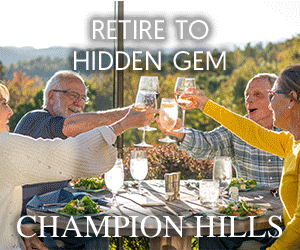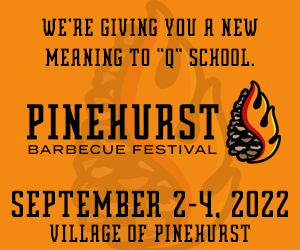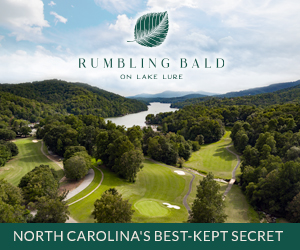To use baseball vernacular, Pinehurst Resort “hit one out of the park” with its restoration of the famed No. 2 course.
Play on the world-renowned Donald Ross design increased by 10 percent last year after it re-opened in March as the architectural team of Ben Crenshaw and Bill Coore created a reverse facelift of sorts, taking the historic layout back to its 1940s roots of hard fairways and wispy, sandy wastelands.
“We went in knowing it might have been a radical step at first to see what we were doing and what we were about,” Crenshaw told Triangle Golf Today in a February interview.
“In so many different ways you are sort of back to the turn of the century when it first started,” added Crenshaw, a Hall of Fame golfer who is also a golf historian. “What it did look like before was the untouched areas all around the Sandhills – a dearth of cultivated grasses and that sort of sandy, wasteland look. When you have sand in a region and pine trees it has a certain look and a certain feel, and that is what was here originally. In discussions and research we wanted to try to re-introduce that.”
Amazingly, if you look at photos of No. 2 at the Tufts Archives in the Village of Pinehurst, Crenshaw and Coore produced a carbon copy Ross design from 70 years ago, like the par-3 ninth hole pictured in this article.
“One day before the project started we went over to the Tufts Archives and they set up a slide show for us and we were in there over 4 hours, just looking at all of the old photos of the ‘30s, ‘40s and ‘50s,” said Don Sweeting, executive vice president of Golf & Club Operations for Pinehurst Resort. “Even though parts of the ‘30s were on sand greens you still got to see what the golf course looked like, all the way up to the U.S. Amateur in ’62. We got to see that, so you have that embedded in your memory and now say, ‘Wow, they really did it, they made it look like it was supposed to.”’
“I don’t think there is any golf course, resort, or golf complex in the nation that has finer archives than Pinehurst,” added Crenshaw. “You sure wished that everyone else would keep them. It is a great, great help when people restore. First and foremost you want to try to portray what was in the mind of an architect, and certainly in this case one of the most significant ones in Donald Ross. We were provided with a kaleidoscope of the past in different eras.”
A course that was virtually wall-to-wall green, Crenshaw and Coore reclaimed many of the sandy areas Ross had designed, tying them into the green complexes and the rough areas that blend into the surrounding tall pines. More than 40 acres of rough was removed and 80,000 wire grass plants were massaged into the landscape by dedicated laborers.
“They touched every bunker by hand,” Sweeting said. “That really made a difference. Instead of big, mechanical equipment and rushing to get through, they took the opposite approach, saying let’s build it as if Donald Ross was here with his team, and they didn’t have all that equipment. They made it perfect.”
As Crenshaw said during the design process, the course may change daily depending on weather conditions as nature has more of the agronomic upper hand now.
“It has proven to be an adventure for us in that it’s always changing. The plants, the native species that are growing in the sandy areas, along with the wire grass have added much more diversity to the landscape,” said Bob Farren, the director of grounds and golf course management at Pinehurst Resort who helped coordinate No. 2’s overhaul. “That has been interesting to observe.”
While none of the routing changed, the renovated course has provided a new look that has helped create a stimulating challenge for golfers.
“It’s something to see with the width of the fairway landing areas in contrast to the sandy, wire grass rough, and the vertical aspect from a landscape perspective with the taller wire grass plants and the sandy mounds,” Farren said. “It just gives the course a more vertical dimension to the landscape, and from a beauty perspective there is such a contract between the sandy areas and the turf. And it’s not all fully irrigated so sometimes it gets dry; you just have different shades of green all the way down to brown.”
With an historic doubleheader of U.S. Opens set for 2014 on course No. 2, USGA executive director Mike Davis has already made a handful of trips to Pinehurst to check out how the renovation might affect play with the pros. He has given positive feedback on the work Crenshaw and Coore produced. Farren said the resort also charted shots during the 2011 North & South Amateur Championships to gauge where certain drives landed or approach shots would be hit from.
“We’ve had great, great discussions with Mike Davis of the USGA, who is not concerned if scores dip a little bit,” Crenshaw said. “We stated many times before what we were trying to do was for the resort. Yes, some for the USGA, but we changed the lines considerably from the USGA, meaning fairway marks themselves. That was a departure from what it was before in the two previous U.S. Opens. The course is the same golf course, but in our minds it is more strategic. That was sort of our bottom line for us.”
“It certainly plays differently, but I haven’t come to the conclusion if it plays easier or more difficult, but there are more varieties of shots to hit, rather than just a fairway shot,” added Farren. “Before it as a tee ball to a narrow fairway, and it was either in a lush fairway or deep Bermuda rough. Now, the fairways are a lot wider, you have more opportunity to hit it in the fairway, but if you won’t hit it into the fairway it’s anyone’s guess as to what kind of lie or what kind of shot you may be faced with when the ball leaves the fairway.
Coore returned recently and was extremely pleased by the maturity of the course and the positive feedback from resort guests.
“To see Bill beaming with happiness and joy was kind of special,” Sweeting said of Coore. “He normally doesn’t do cartwheels. He’s pretty reserved. He had a smile and ear-to-ear grin about his work on No. 2.
“People have seen it during the U.S. Opens and on TV through the years, so you would have to be history buffs to really understand exactly what the golf course used to look like, so golfers really want to come back and see it,” Sweeting said. “They want to touch it, feel it, play it, to see how really special it is.”

















